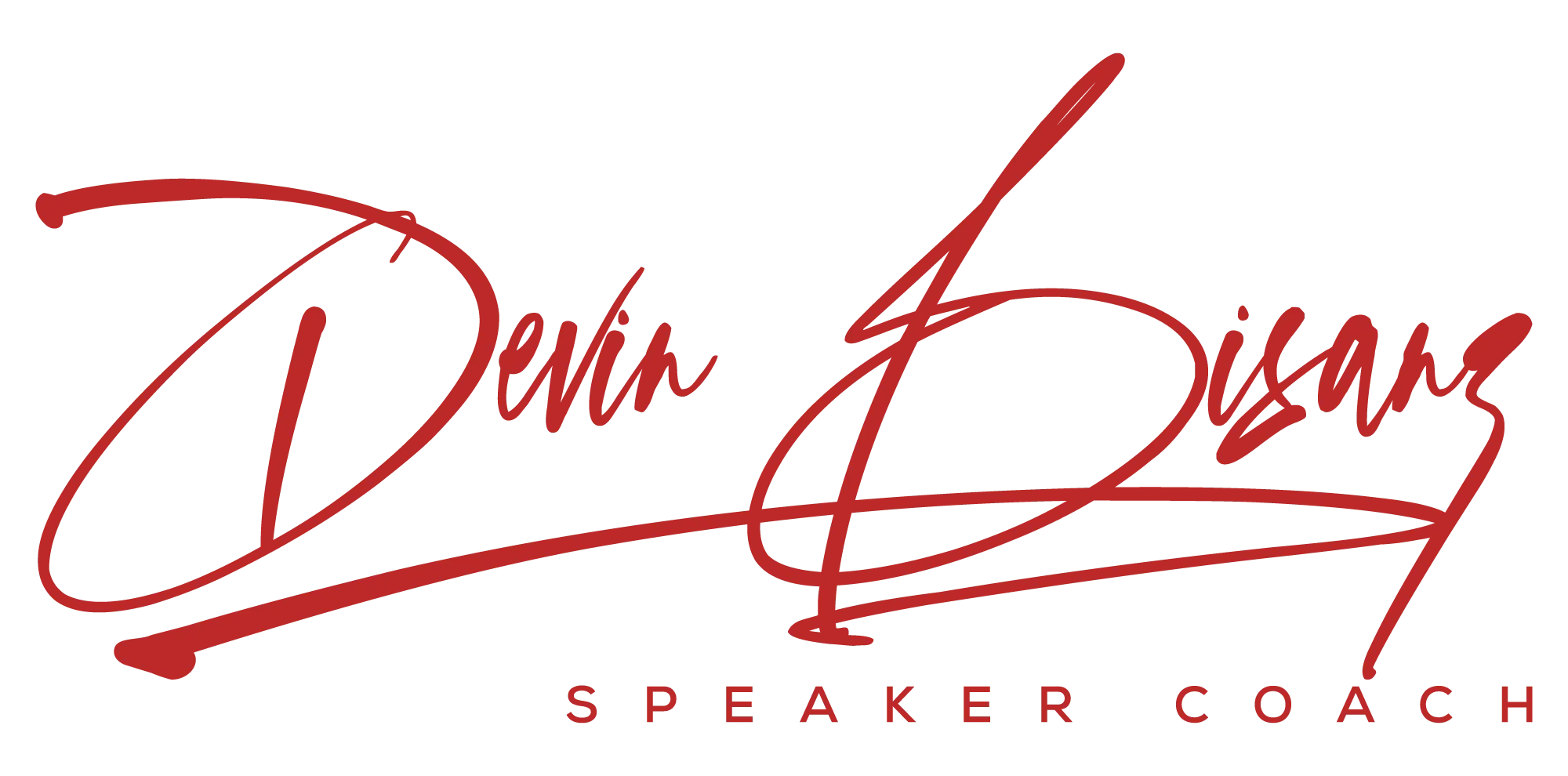Unleash Your Potential: A Step-By-Step Guide To Building A Thriving Speaking Business From Scratch
Public speaking is a critical life skill that can help individuals advance in their careers, improve their self-confidence, and effectively communicate their ideas and messages to others, agree?

The business of speaking is the money machine. Speaking businesses can vary from training services to keynotes to being the CEO of a large company.
The purpose of this blog is to provide a comprehensive guide for starting a public speaking business from scratch. We are going to to do it in 9 steps.
Step 1. Identify Your Niche
If you’re building a speaking business then you have to be in a position to go for it.
What are you passionate about and what expertise do you have that can help others? It could be anything from motivational speaking to teaching a specific skill. Once you've identified your niche, you can start to position yourself as an expert in that area.

Step 2: Understanding the Market
Part I: To successfully build a public speaking business, it's crucial to understand who your target audience is. This could include professionals, entrepreneurs, students, government officials, the military, the crocheting community, or whomever you serve.
Your ideal market might change or evolve but I suggest picking a market you are willing to stick with for at least 4 years. You're going to be sinking so much time and effort into all your speaking materials and you don't want to restart in two years.
My situation is a classic case of evolution: I started training youth speakers and along the way I trained a few executives and I was like, “Daaang, this is so much better.”
I suddenly wanted to get out of youth training.
Instead of saying, "Screw the kids." I still offer youth speaking programs but I focus my time and energy on landing corporate clients but guess what... corporate clients needed new proposals, course outlines, testimonies, marketing material, and books. That's a lot of work.
My suggestion: get clear on your target audience and stick to them for 4 years.
Finish this sentence with clarity: I want to speak to ________________________.
And NO, the answer is not everybody.
The most specific your answer is the better. A good answer might be: I want to speak to crochet enthusiasts. I want to speak to Junior A Hockey Goalies. I want to speak at high school assemblies. I want to speak to Fortune 500 CEO's.
Be Specific!

Part II: Researching the competition.
Researching your competition is essential in order to understand the market and what others are offering. This information can help you differentiate your services and determine what makes your business unique.
You’re going to quickly realize the HIGH caliber of speakers already out there talking about what you want to talk about..
Your amazing speaking topic is COVERED by many speakers.
You may feel like there is no point pursuing a career in speaking.
If you give up at this point you were not cut out for the speaking business.

You should start a google docs or excel sheet and make notes on competitors websites, the competitors main messages, their marketing material, where they’ve spoken, what kind of courses they offer.
By keeping notes you’ll start seeing how your angle is DIFFERENT.
Follow the competitors' sales funnels, do their free consulting calls. Find out what they say, what website and CRM systems they use, and how they sell their product.
I know, it's time consuming, but the more you know about your competition, the better you'll be able to position yourself and your offer.
Who can skip this step? Industry experts can skip this step because they already know everything about the competition.
The more you know about your competition the better. Check their youtube videos, what are they saying on socials, how many followers do they have?
I just started posting this year on my socials. I started with ZERO followers. I bet everybody has more followers than I do!!! Hahah, BUT, I know almost everything about my competition!
If you’re like me then you are willing to go the distance with your head down grinding.
Step 3: Developing a Business Plan

Part I: Defining clear goals and objectives for your business is crucial in order to measure success and stay on track. This could include financial targets, customer acquisition goals, or milestones for expanding your services.
There are two schools of thought here, some people make very detailed goals, and people like me make visions.
I like to have a vision because you could say, "I’m going to post a blog every week (which is my goal for 90 days)," but if you miss one week, then two weeks and that goal is out the window. You’ll give up like fitness fanatics at New Years.
If you have a vision and a mission like I do: to be the best speaking coach on the planet! Then you may write 2 blogs/year (which I’ve done before), but you’ll never give up. You have a mission and you keep going no matter how small the action is.
I used to tell people that if it took 40 years to become a professional speaker then I’d take 40 years. Luckily, it only took me 10 years.
But think about that... for 10 years I had to go through not having a clear message (it was changing every 6 months), or a defined audience (I went from I'm going to speak at high schools to keynoter to nobody likes me to just giving up), or the knowledge of how to find an audience (I only worked from referrals). I was afraid to own my shit, but by just taking it one tiny step at a time toward my vision I'm in a different position today.
I hope you have already achieved great heights and you want to get paid for your achievements.
If not, I hope you have grit and determination.
Part II: Determining the services offered. Deciding on the services you will offer is a critical aspect of starting a public speaking business. This could include coaching, consulting, workshops, keynotes, Emceeing, or online courses.
Your first services are going to suck, so I suggest just getting what you have out there. Your first website isn’t going to be you, or your second one or third.
But you need a website.
Listen, if you don’t have at least 10k to sink into your branding and web development… you have to do it alone. Get started today. Grab a domain name at any provider like godaddy and then start a website.
Don't think about it... save this page and get your name domain now!
I’ll write a future blog about tools for DIY professional speakers.
The short list is to get a web builder like Wordpress or Wix. I personally use Groove Funnels. I like it because it has everything (websites, sales funnels, store, payment processor, mailer), and I was an early adopter so I got a special discount on a life membership. BUT, it’s worth the investment if you want to offer courses and services as a part of your business.
That’s the short list… then you’re going to want to learn how to write copy. Lucky you, today we have AI to help you get started. I used CHATGPT for the outline of this blog. It even wrote some of the paragraphs… Do you know which ones?
Just go to www.chat.openai.com and type in, 'write a headline for {your speaking business}.' If you don't like the headline then ask the chatbot to change it. The headline for this blog was written by ChatGPT.
The pictures are from another AI creator labs.openai.com.
Part III: Set your fees. Establishing a pricing strategy that is competitive and profitable is crucial for success. This will involve determining the costs associated with delivering your services and the pricing that is appropriate for your target audience.
Consider factors such as the length of your speech, the size of the audience, and your level of expertise when determining your fees. It's important to charge a fair price that reflects the value you bring to the table.
True story: I started out my speaking business making $8.50/hour after travel expenses and travel time.
I ate the costs because I was working out material and I wanted referrals and testimonies. Every time I got a new referral I charged more. I went from $25/hour to $150/hour for online training within three years. That's a fraction of what I'm going to make per hour in the next three years.
Most of my friends were saying, “You should charge way more. Your services are worth a lot.”
Well, your services are worth nothing if you’re the only one saying it. Fact.

Step 4. Building a Strong Brand
Part I. Choosing business name. Select a business name that is memorable, relevant, and reflective of your brand is essential.
As for my Business... I was training a group of managers and I wanted to give them a Golden Mike Trophy. I asked my wife, “What company name should I put on the trophy?”
She said, “I don’t know, use your name. How about Bisanz Advanced Speaker Training?”
I said, “Okay… and I can shorten that to BA Speaker Training, you know like B.A. Bachelor of Arts! Ahhhhhhhhhhh.”
My point is, I was training almost full time without even a business.
Part II: Creating a logo and visual identity. Designing a logo and visual identity that is unique and memorable is a critical component of building a strong brand.
For the DIYers, use Canva, or another free service for your logos. If you have a few hundred dollars to spend then use a freelance site like fiverr, or I'm sure there are better freelance sites out there. I do it all myself for now. I've changed my plan too much to afford new logos every time.
Part III: Developing a brand voice that is consistent and reflective of your business's personality is important for establishing a strong brand identity.
You want to be able to explain what you talk about in one sentence. Go ahead and finish this sentence:
I help people ____________________________.
As for me: I help people understand body language for public speaking.
Fun fact: I just defined my brand voice January of 2023. I had a loud voice but I couldn't tell you in a single sentence what my message was. I'm just a do'er. I take action. I was a trainer with no real message, but now I have something to talk about.
From there you build out your brand colours, feeling, and marketing material.
One thing that really helped me was my friend's company https://www.gogotelugo.com/. My friend, Azadeh asked me what emotions I wanted to evoke with my brand. I said things like action, wealth, and trust.
Then I went and looked up colour pallets, ran it by her and now most things I do use the same colours, except Instagram and TikTok Posts. Just the fact that I'm posting is all I need for now.
Having brand colours makes it simple because you don’t have to think.
The less thinking you have to do when it comes to building your brand the more you can focus on stage time.
Part IV: Use your brand colours and voice to create your speaking portfolio.
To showcase your skills and build credibility as a speaker, you'll need to create a portfolio. This can include recordings of your speeches, testimonials from past clients, and any relevant media coverage. Make sure your portfolio is easy to access and showcases your strengths as a speaker.
What you need:
- Speaking reel (video of you delivering presentations) mine is below. It doesn't have to be fancy smanchy to get started.
- Speaker One Sheet: an outline of your talk with key takeaways.
- Media Kit: Headshots, testimonials, where you've been featured, your workshops and keynotes, and anything that can be used to market you (to get started you just need a headshot and testimonials).
- Here is a link to my media kit which I'm updating now... CLICK! This is my 3rd media kit.
- A ready to go presentation!!!
Step 5. Creating a Website
A professional website is essential for establishing credibility, attracting new clients, and promoting your services.
I DIY’d my site and it took about 600 hours of my time before I got my first online lead.
I could help you DIYers make it much quicker than I did, I’ll lay it out in a future post.
Working with a company could do it faster so if you have money. Go talk to my Friend Azadeh at https://www.gogotelugo.com/ Azadeh will help you craft your message and your brand. She is a branding expert.
Essential components of a public speakers website: an Introduction to your business page.
That's right, just one page, and then you submit that page to Google Console, Bing Console, and other directories.
Then you create more pages over time; speaking topics, Testimonials, Contact page, and a Blog.
yes; a blog, because it’ll help you with SEO in the future.
Best practices for website design and development include creating a user-friendly interface, incorporating high-quality images, and optimizing for search engines.
Again, I got my first clients with a shitty speaker reel, a course outline, and a one page website about me.

Step 6. Marketing and Networking
Utilizing social media platforms such as Facebook, Twitter, and LinkedIn is a cost-effective way to reach your target audience and promote your services.
My story: I never posted on socials, didn’t even like socials… BUT, I need them so this year, 2023, I started updating my Instagram and TikTok page weekly with the same videos. I make a weekly post on Linkedin, and I post part-time on Youtube, just videos I want to use for my site.
Building relationships with other industry professionals is a great way to expand your network and increase visibility for your business.
This is good, join a business networking group (BNI) or a if you’re making a bit of money through speaking, or offer a service to speakers join a National Speaking Association (NAS/CAPS)
Participate in speaking engagements as much as possible. Even if it’s just at work, ask the main presenter of any meeting if you can tell a quick joke. Many people say yes, and it’s how I get heard and often recommended.
Participating in speaking engagements is a great way to showcase your skills and build your reputation as a public speaking expert. This could include giving talks at local events, participating in webinars, or hosting workshops.
Step 7. Delivering Quality Services
Understanding the needs of your clients is crucial in order to provide personalized and effective presentations.
You’re a speaker now so I’m assuming you’re delivering top notch speeches using all the tools of persuasion, humour, hook phrases, and all the goodies.
Continuously seeking feedback from clients and seeking opportunities to improve your services is essential for delivering the best possible experience to your clients.
I’ve had engagements where everybody was praising me after, and wanting to shake my hand… then I sent out a feedback form and I got an overall grade equivalent to 75%.
That’s shit! But everybody was praising me?
Yes, they praised my speaking, but I had to do some work on my material. I would have never known that if I never asked the entire audience for feedback, not just the people who praised me.

Step 8. Managing Finances
Congratulations, you’ve made it! You’re making money as a speaker. At first, gigs might be few and far between so you have to get your finances in order.
I used to just pray that I made enough to cover my bills, and still do sometimes!!!
Establishing a budget for your business is crucial in order to manage finances effectively. According to experts this should include projections for income and expenses, and should be reviewed regularly.
According to me; take massive action and get started with the first 7 steps!
According to experts keeping accurate and detailed records of all expenses is essential for managing your finances. This could involve using accounting software or working with a bookkeeper.
I've always been lucky to have an accountant. I run everything through the business.
Seeking the advice of a financial professional, such as an accountant or financial advisor, can help you make informed decisions and effectively manage the finances of your business.
Conclusion
The key takeaways from this blog include understanding your target audience, developing a business plan, building a strong brand, creating a website, marketing and networking, delivering quality services, managing finances, and continuously improving your business.
Building a successful public speaking business requires hard work, dedication, and a commitment to providing quality services. With the right strategies and support, anyone can turn their passion for public speaking into a thriving business.
My suggestion, think of the long game!!! Visualize, map it out, and in the words of Dory, “Just keep swimming!”
If you want to skip the reading and take action on doing let me help! Book a 15-minute strategy session to get started!
